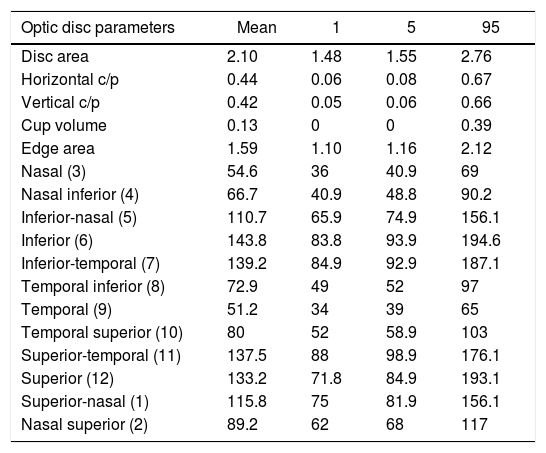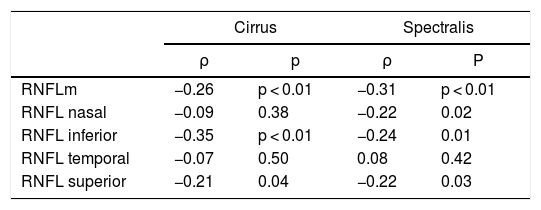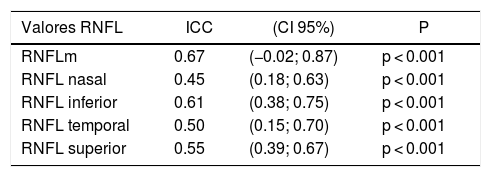To assess absolute agreement and differences in peripapillary retinal nerve fiber layer (pRNFL) values according to sex, age, laterality, origin and optical coherence tomography (OCT) type in normal pediatric patients undergoing OCT scans using both Cirrus and Spectralis.
Material and methodsProspective, cross-sectional, and comparative study. We used Spectralis OCT and Cirrus OCT to measure optic disc values of both eyes in one hundred pediatric patients (age 5–15 years), with no previous ocular pathology or systemic disease that could affect the eye. Due to the similarity between eyes, only right eyes were considered (n = 100).
ResultsThe average peripapillary retinal nerve fiber layer (pRNFL) values were 99.6 μm with Cirrus and 106.7 μm with the Spectralis system. The four quadrants followed the ISNT rule (inferior-superior-nasal-temporal). The average pRNFL measures correlated negatively with the AL (P < 0.01) in both OCTs, and the degree of agreement between OCTs for pRNFL and inferior RNFL was moderate (CCI: 0.67 and 0.61, respectively), and low in the rest of the sectors. The average pRNFL values of both OCTs were higher in women than in men (P > 0.05) and there were also no statistical differences in the pRNFL according to age or laterality (P > 0.05). All RNFL values were significantly different between both types of OCTs (P < 0.05) and average pRNFL values were significantly thicker (P < 0.05) in Latin American than in European children in both eyes.
ConclusionsWe suggest that the respective peripapillary RNFL values obtained using these two OCTs should not be considered interchangeable in pediatric patients.
Determinar el grado de concordancia y las diferencias entre los valores medios de las capas de fibras nerviosas de la retina (CFNRm) peripapilar en función del sexo, la edad, la lateralidad, la etnia y el tipo de tomografía de coherencia óptica (OCT) en pacientes pediátricos.
Material y métodosEstudio prospectivo, transversal y comparativo. Se utilizó tanto la OCT Spectralis como la OCT Cirrus para medir los valores del disco óptico de ambos ojos en 100 pacientes de entre 5 y 15 años sin patología ocular. Debido al alto grado de semejanza en los valores de ambos ojos al llevar a cabo el análisis estadístico, y para evitar sesgos, en la muestra final solo consideramos los ojos derechos (n = 100).
ResultadosLos valores de CFNRm fueron de 99,6 μm con Cirrus y de 106,7 μm con Spectralis. Las mediciones de CFNRm mostraron correlación negativa con los valores de la longitud axial (p < 0,01) para ambas OCT. Mediante el coeficiente de correlación intraclase (CCI), el grado de concordancia entre los valores de CFNRm y entre los valores de CFNR inferior fue moderado (CCI: 0,67 y 0,61, respectivamente), y bajo en el resto de los sectores. Los valores de CFNRm para ambas OCT fueron mayores en mujeres que en varones (p > 0,05), y tampoco se obtuvo significación estadística según la edad o la lateralidad (p > 0,05). El valor de CFNRm fue significativamente más alto en pacientes de etnia latinoamericana que en pacientes de etnia europea.
ConclusionesLos valores de CFNR peripapilar obtenidos mediante OCT Spectralis y OCT Cirrus no deberían ser usados indistintamente en pacientes pediátricos.
Artículo
Comprando el artículo el PDF del mismo podrá ser descargado
Precio 19,34 €
Comprar ahora











